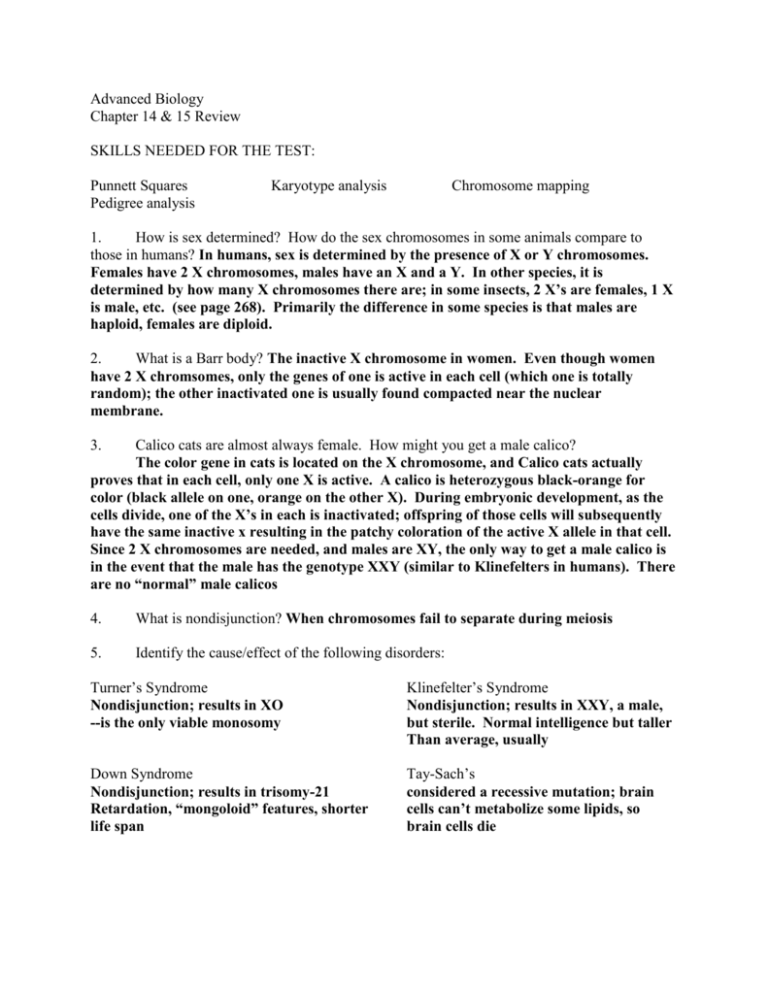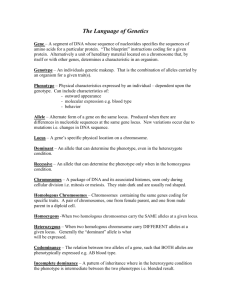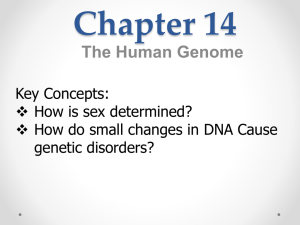Advanced Biology
advertisement

Advanced Biology Chapter 14 & 15 Review SKILLS NEEDED FOR THE TEST: Punnett Squares Pedigree analysis Karyotype analysis Chromosome mapping 1. How is sex determined? How do the sex chromosomes in some animals compare to those in humans? In humans, sex is determined by the presence of X or Y chromosomes. Females have 2 X chromosomes, males have an X and a Y. In other species, it is determined by how many X chromosomes there are; in some insects, 2 X’s are females, 1 X is male, etc. (see page 268). Primarily the difference in some species is that males are haploid, females are diploid. 2. What is a Barr body? The inactive X chromosome in women. Even though women have 2 X chromsomes, only the genes of one is active in each cell (which one is totally random); the other inactivated one is usually found compacted near the nuclear membrane. 3. Calico cats are almost always female. How might you get a male calico? The color gene in cats is located on the X chromosome, and Calico cats actually proves that in each cell, only one X is active. A calico is heterozygous black-orange for color (black allele on one, orange on the other X). During embryonic development, as the cells divide, one of the X’s in each is inactivated; offspring of those cells will subsequently have the same inactive x resulting in the patchy coloration of the active X allele in that cell. Since 2 X chromosomes are needed, and males are XY, the only way to get a male calico is in the event that the male has the genotype XXY (similar to Klinefelters in humans). There are no “normal” male calicos 4. What is nondisjunction? When chromosomes fail to separate during meiosis 5. Identify the cause/effect of the following disorders: Turner’s Syndrome Nondisjunction; results in XO --is the only viable monosomy Klinefelter’s Syndrome Nondisjunction; results in XXY, a male, but sterile. Normal intelligence but taller Than average, usually Down Syndrome Nondisjunction; results in trisomy-21 Retardation, “mongoloid” features, shorter life span Tay-Sach’s considered a recessive mutation; brain cells can’t metabolize some lipids, so brain cells die Huntington’s degenerative disease of the nerVous system; lethal dominant train not expressed until late in life Phenylketonuria recessive; can’t break down phenylalanine. Can result in retardation Hemophilia Sex-linked “bleeders” disease or the “King’s Evil” because it was common in Royal families Sickle-cell Disease substitution of a single amino acid in hemoglobin; results in an inability of red blood cells to carry hemoglobin; is treatable but there is not cure Muscular Dystrophy Sex-linked; weakening of muscles and Loss of coordination. Rarely live past their 20s Fragile X Syndrome related to genomic imprinting; more common in males; retardation likely 6. What does it mean to be hemizygous? Refers to sex chromosomes that do not contain the same genes, and therefore can’t be either homozygous or heterozygous 7. What could be considered good evidence for linkage of genes? When 2 traits are always inherited together 8. Differentiate between a gamete and a zygote. A gamete is egg or sperm (a haploid cell). The zygote is a union of the 2, and is diploid 9. What is a locus? An allele? Alleles are alternate forms of a gene (tall/short, red/white). The locus is the specific location of the allele on a chromosome 10. What is genomic imprinting? The effect of a gene depending on whether or not it was inherited from the mother or father. For example, Prader-Willi syndrome and Angelman syndrome. Both seem to be caused by a deletion from chromosome 15. If the abberant chromosome was inherited from the father, the result is Prader-Willi; if from the mother, Angelman 11. Discuss the possible results of the following alterations to a chromosome: Deletion a nucleotide sequence is left out during transcription or translation Inversion sequence is “flipped over” Translocation sequence is moved to a new location Duplication sequence is copied more than once 12. What is a tetrad? When homologous chromosomes pair up during Meiosis I and recombination can occur 13. What are the Mendelian principles? Dominance and recessiveness, segregation, and independent assortment 14. What is pleiotropy? The effect of one mutation on more than one traits 15. What is significant about the Rh factor when it comes to pregnancy? If mom is Rh- and the baby ends up Rh +, a lethal condition may occur in the fetus called erythroblastosis fetalis. If the baby’s blood leaks across the placental barrier, it may cause the mother’s immune system to create antibodies to it, as it would if she had deliberately been given the wrong blood type. The antibodies are able to cross the placental carrier, and attach the baby’s own blood in the body 16. Explain the pattern of inheritance for each of the following, and how it affects might affect phenotypic ratios where applicable: incomplete dominance the heterozygote is an intermediate to the homozygotes codominance both alleles are fully expressed sex-linked traits on the X chromosome (most are x-linked); affects males more often, as they have only on X pleiotropy the ability of a gene to affect an organism in many ways (multiple symptoms), i.e., sickle-cell disease multiple alleles more than 2 possible alleles for a trait, though only 2 can be present in a given organism (A-B-O blood system epistasis a gene at one locus affects the expression of a gene at another locus, i.e., coat color in mice. Two genes contribute to the color—one by pigment (kind of pigment, B or b) and one for the ability to produce a coat at all (C or c). Even if an organism has the dominant color gene (B), it could not be produced if there is no C to let it happen. 17. What is a test cross? The mating of an unknown genotype to the homozygous recessive 18. Given the parents PPTTIi x PpttIi, and assuming simple dominance and independent assortment, what are the proportion of progeny that will be expected to phenotypically resemble the first parent? ¾ 1/1 x 1/1 x ¾ = 3/4









